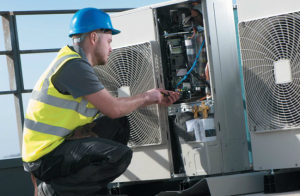 The following article written by Brock Studinski, VP of Energy & Technical Services at Evergreen Air Conditioning, was recently published in the January / February issue of Professional Retail Store Maintenance.
The following article written by Brock Studinski, VP of Energy & Technical Services at Evergreen Air Conditioning, was recently published in the January / February issue of Professional Retail Store Maintenance.
It’s nothing new for FM professionals to find themselves confronted with questions regarding how to reduce spending or cut costs. However, many facilities managers increasingly find they are also being challenged to be “green” or save energy.
Some FMs may be overwhelmed when it comes to discussing the nuances of HVAC, but it really boils down to two basic principles: First, how to effectively transfer heat from inside your store to the outside and second, how to distribute that now cooled air to the space. Here are five quick tips to make sure your HVAC system runs more efficiently.
- Belts – Consider using notched or cog-style belts. Studies by the Department of Energy show that notched belts allow for less slippage and generate less heat, prolonging the life of the belt. A notched belt for a 20-ton unit may cost $6 – $9 more than a traditional “V” belt, but it will save nearly $40 in electrical costs. Now compound that by thousands of HVAC units, and you will see tens, if not hundreds or thousands of dollars in savings annually. The link to a free calculator can be found here.
- Filters – Link (ring) or pleated? What MERV rating is preferable? How many changes are required per year? These are just a few of the questions you need to answer when selecting filters. Unfortunately, there are no easy answers to most of those questions, as it really comes down to the application. Everyone will agree, however, that is a very important to make sure the incoming air is completely filtered in order to protect the evaporator coil. If you select a filter that is too restrictive, you force your fan to work harder to overcome the added pressure drop. However, if you choose a filter with too little capacity, you risk fouling your coils and causing your refrigeration system to work overtime.
- Coils – Keeping your refrigerant coils clean is key to ensuring that your system can effectively condition your store, prolonging the life of the system and keeping your utility costs down. Moderately fouled coils can increase electrical costs by as much as 30 percent. If you are unable to transfer enough heat to the airstream, you also risk frosting or freezing the coil.
- Refrigerant – If there is not enough refrigerant in the system, you risk not being able to fill the coils and, as a result, impeding heat transfer. On the other hand, if you have a system that is overcharged, the refrigerant will have a difficult time changing state and transferring heat. Think of your air conditioning system like baking bread: If the oven is too cool, your bread will not set; if it is too hot, you burn it.
- Condenser fans – As manufacturers strive to increase the efficiency of their products, it’s more important than ever to keep all of the components working. The condenser fans are often overlooked because, in most cases, there are multiple fans on each unit. But just as indoor (evaporator) fans are important in transferring heat to cool the space, condenser fans complete the cycle by transferring that heat outside. If the fans are not operational, you run the risk of increasing refrigerant pressures and not being able to adequately cool the space, not to mention shortening the life of the other components.
View this article as it appeared in Professional Retail Store Maintenance magazine.
